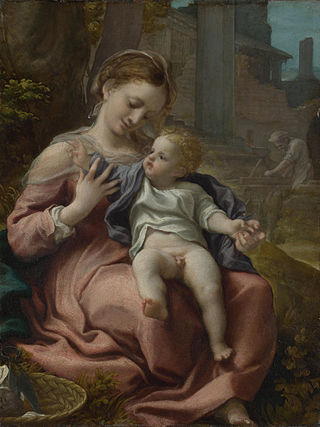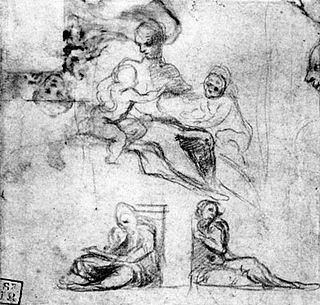
The Pinacoteca del Castello Sforzesco is an art gallery in the museum complex of the Castello Sforzesco in Milan, northern Italy.

The Madonna of the Basket or the Madonna della Cesta is a painting of c. 1524 by Antonio da Correggio in the National Gallery, London. While it is a Mannerist painting of the Virgin Mary and the Baby Jesus, Correggio included naturalist touches in his composition, like the sewing basket that gives the painting its name.

The Camera di San Paolo or Camera della Badessa is a room in the former Monastery of San Paolo, in Parma, northern Italy. It is painted with frescoes by Correggio in the vault (697x645 cm) and over the fireplace.

Portrait of a Man with a Book is an oil on canvas painting by Correggio, dated to around 1522. It was bequeathed to the Pinacoteca del Castello Sforzesco in Milan in 1945 by Lydia Caprara Morando Attendolo Bolognini. It is sometimes instead attributed to Parmigianino but majority opinion is that it dates to Correggio's first mature period, which is supported by the fact that it was painted directly on top of the sketch, an informal technique suggesting it was made for a close friend of the artist.

Madonna and Child with St Francis or Madonna of St Francis is a 1514-1515 painting by Correggio, now held in the Gemäldegalerie Alte Meister in Dresden, Germany. It shows Francis of Assisi, with the stigmata, prostrating himself before an enthroned Madonna and Child - the work's theme is the intercession of the Madonna, which was promoted by the Franciscans after the definition of the dogma of the Immaculate Conception in 1473. Francis is supported by Anthony of Padua, whilst on the right are Catherine of Alexandria and John the Baptist and on the base of the Madonna's throne is a small grisaille image of Moses with the tablets of the law. Catherine's wheel bears the painter's signature "Antonivs de Alegri F.[ecit]".

The Madonna and Child with the Infant John the Baptist is a 1513–1514 painting by the Italian artist Correggio.

The Madonna and Child with the Infant John the Baptist is a 1518 oil on panel painting by Antonio da Correggio.

The Allegory of Vice is an oil on canvas painting by Correggio dating to around 1531 and measuring 149 cm (59 in) by 88 cm (35 in).

The Allegory of Virtue is an oil on canvas painting by Correggio dating to around 1531 and measuring 149 by 88 cm. It and Allegory of Vice were painted as a pair for the studiolo of Isabella d'Este, with Vice probably the second of the two to be completed. This hypothesis is since only one sketch survives for Vice, unlike Virtue, for which two preparatory studies survive, along with a near-complete oil sketch - this suggests Correggio had become more proficient after the difficult gestation of Virtue.

The Casalmaggiore Madonna is a lost oil on canvas painting by Correggio, measuring 28 by 24 cm and painted around 1522.

The Madonna and Child with Two Musician Angels is an oil on panel painting by Correggio, now in the Uffizi in Florence. Some date it to 1514-15 but it is more commonly dated to 1515–16.

Holy Family with Saints Elizabeth and John the Baptist is an oil on panel painting, dating to around 1510, sometimes attributed to Correggio. It measures 28 by 21.5 cm and is now in the Pinacoteca Malaspina in Pavia.

Holy Family with the Infant Saint John the Baptist is a small oil on canvas painting, attributed to Correggio and dating to around 1514. It is now in the Los Angeles County Museum of Art, where it has been since 1946.

The Holy Family with Saint Jerome is a 68 by 56 cm oil on poplar panel painting by Correggio. It dates to around 1515 and is now displayed in the East Closet of Hampton Court Palace as part of the Royal Collection. It has similarities with the Holy Family with the Infant Saint John the Baptist and so it probably dates to around the time Correggio painted the frescoes in the Camera di San Paolo or possibly slightly earlier. It shows the Holy Family and saint Jerome.

Madonna and Child with Saint George is an oil on panel painting by Correggio dating to around 1530 and now in the Gemäldegalerie in Dresden.

Madonna and Child is a c. 1460–1465 tempera on panel painting by Giovanni Bellini, signed on the trompe-l'œil parapet. It dates from his early phase, when he was still strongly influenced by his father Jacopo and by Andrea Mantegna. The Christ Child holds a fruit, symbolising Original Sin and foreshadowing his Passion. Some art historians feel the haloes and drapery are too archaic for the work to be by Bellini, but the signature's authenticity was confirmed by a 1999 restoration.

Judith and Her Maidservant or Judith and Her Maidservant with the Head of Holofernes is a circa 1510–1514 oil on panel painting by Correggio, now in the Musée des Beaux-Arts of Strasbourg, France. Its inventory number is 252.

Lamentation over the Dead Christ is an oil painting on canvas of c. 1515–1520 by Bramantino, painted for the church of San Barnaba in Milan. The work was acquired by the Werner family in 1985 and now in the Pinacoteca del Castello Sforzesco in the same city. A copy is now in a private collection.

Mystic Marriage of Saint Catherine or Mystic Marriage of Saint Catherine with Three Saints in a Landscape is a c. 1512 oil on panel painting by Correggio, now in the Detroit Institute of Arts. It is usually dated to the artist's youth, before Madonna and Child with St Francis (Dresden) and after Mystic Marriage of Saint Catherine (Washington).

Saint John Fleeing Christ's Arrest is a c. 1522 oil on canvas painting now in the Galleria nazionale di Parma. It is a copy of a lost original by Correggio.





















